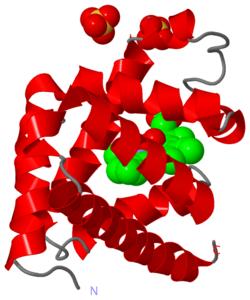JMS/sandbox15
From Proteopedia
(Difference between revisions)
| Line 12: | Line 12: | ||
'''Their hypothesis was that whales''' and other aquatic animals can hold their breath for so long because they can store more oxygen in their muscles by increasing the concentration of '''[[Myoglobin]]''', the protein that stores oxygen in muscle tissue. | '''Their hypothesis was that whales''' and other aquatic animals can hold their breath for so long because they can store more oxygen in their muscles by increasing the concentration of '''[[Myoglobin]]''', the protein that stores oxygen in muscle tissue. | ||
| - | Specifically, they predicted that species could increase the concentration of myoglobin by increasing its solubility through increasing the number of positively charged regions on the protein's surface, so that | + | Specifically, they predicted that species could increase the concentration of myoglobin by increasing its solubility through increasing the number of positively charged regions on the protein's surface, so that even at high concentration the electrostatic repulsion between the myoglobin proteins would prevent their aggregation. |
'''Amazingly, they found an association''' between an animals' ability to hold its breath, higher concentrations of myoglobin in muscle tissue, and an increase in its net charge (taken as a ''proxy'' for an increase in the number of positively charged regions on the surface). Typically, purified terrestrial mammal's myoglobin has a solubility of 20 mg/g in an aqueous solution at neutral pH ([http://www.sigmaaldrich.com/content/dam/sigma-aldrich/docs/Sigma/Product_Information_Sheet/2/m0630pis.pdf Sigma Aldrich]) which turns out to be the maximum level of myoglobin found in most terrestrial mammal's tissue. But whales and other aquatic mammals far exceed this solubility limit, e.g., whales have 70 mg/g. The way that they overcome the solubility constraint may be traced back to a modest increase in the net charge of myoglobin - from around +2 in terrestrial animals to around +4 in aquatic animals. | '''Amazingly, they found an association''' between an animals' ability to hold its breath, higher concentrations of myoglobin in muscle tissue, and an increase in its net charge (taken as a ''proxy'' for an increase in the number of positively charged regions on the surface). Typically, purified terrestrial mammal's myoglobin has a solubility of 20 mg/g in an aqueous solution at neutral pH ([http://www.sigmaaldrich.com/content/dam/sigma-aldrich/docs/Sigma/Product_Information_Sheet/2/m0630pis.pdf Sigma Aldrich]) which turns out to be the maximum level of myoglobin found in most terrestrial mammal's tissue. But whales and other aquatic mammals far exceed this solubility limit, e.g., whales have 70 mg/g. The way that they overcome the solubility constraint may be traced back to a modest increase in the net charge of myoglobin - from around +2 in terrestrial animals to around +4 in aquatic animals. | ||
Revision as of 16:01, 11 May 2014
| |||||||||||
References:
- ↑ 1.0 1.1 Mirceta S, Signore AV, Burns JM, Cossins AR, Campbell KL, Berenbrink M. Evolution of mammalian diving capacity traced by myoglobin net surface charge. Science. 2013 Jun 14;340(6138):1234192. doi: 10.1126/science.1234192. PMID:23766330 doi:http://dx.doi.org/10.1126/science.1234192
- ↑ Brocchieri L. Environmental signatures in proteome properties. Proc Natl Acad Sci U S A. 2004 Jun 1;101(22):8257-8. Epub 2004 May 24. PMID:15159533 doi:http://dx.doi.org/10.1073/pnas.0402797101
- ↑ Goh CS, Lan N, Douglas SM, Wu B, Echols N, Smith A, Milburn D, Montelione GT, Zhao H, Gerstein M. Mining the structural genomics pipeline: identification of protein properties that affect high-throughput experimental analysis. J Mol Biol. 2004 Feb 6;336(1):115-30. PMID:14741208 doi:http://dx.doi.org/10.1016/S0022283603014748

